A sphere is a perfectly round three-dimensional shape where every point on its surface is equidistant from the center. It has unique geometric properties that are fundamental in mathematics, physics, and engineering, influencing concepts ranging from volume calculations to orbital dynamics. Explore this article to deepen your understanding of spheres and discover practical applications that can enhance your knowledge.
Table of Comparison
| Aspect | Sphere | Ellipsoid |
|---|---|---|
| Definition | A perfect 3D circle with constant radius | An oblate spheroid flattened at the poles |
| Shape | Uniform curvature | Varied curvature, flattened poles |
| Radius | Single constant radius | Two radii: equatorial (longer) and polar (shorter) |
| Use in Geodesy | Simple Earth model, less accurate | Accurate Earth shape model, used in GPS and mapping |
| Accuracy | Low for Earth shape | High, accounts for Earth's flattening |
| Examples | Perfect sphere, basic models | WGS84, GRS80 ellipsoids |
Introduction: Sphere vs Ellipsoid
A sphere is a perfectly round three-dimensional object where every point on the surface is equidistant from the center, resulting in uniform curvature. An ellipsoid, by contrast, is a more general geometric shape characterized by three mutually perpendicular axes of different lengths, producing varied curvature and dimensions. These differences in shape and axis lengths significantly impact their applications in fields like geodesy, astronomy, and computer graphics.
Defining the Sphere
A sphere is a perfectly symmetrical three-dimensional shape where every point on the surface is equidistant from the center, defined by a single radius. Unlike an ellipsoid, which has three semi-axes of varying lengths, the sphere's radius remains constant in all directions, resulting in a uniform curvature. This geometric property ensures that spheres maintain consistent surface area and volume formulas, making them fundamental in fields such as physics, geometry, and computer graphics.
Understanding the Ellipsoid
An ellipsoid is a three-dimensional geometric figure characterized by three mutually perpendicular axes of different lengths, forming a shape that generalizes a sphere. Unlike a sphere, which has a constant radius in all directions, an ellipsoid's varying radii better approximate the shape of celestial bodies like Earth. This distinction makes ellipsoids fundamental in geodesy and navigation, where accurate modeling of planetary shapes is crucial for mapping and satellite positioning.
Key Geometric Differences
A sphere is defined as a perfectly round three-dimensional shape with all points equidistant from its center, characterized by a single radius. In contrast, an ellipsoid has three mutually perpendicular axes of different lengths, resulting in varying radii and an elongated or flattened shape depending on the axis dimensions. The key geometric difference lies in uniform curvature for a sphere versus varying curvature along its axes in an ellipsoid.
Mathematical Formulas and Equations
A sphere is defined by the equation x2 + y2 + z2 = r2, where r represents the constant radius. An ellipsoid generalizes this with the formula (x2/a2) + (y2/b2) + (z2/c2) = 1, where a, b, and c denote the radii along the x, y, and z axes, respectively. Calculations involving surface area and volume differ, with volume for a sphere given by (4/3)pr3 and for an ellipsoid by (4/3)pabc, highlighting the dimensional variations in these quadratic surfaces.
Real-World Applications
Spheres are widely used in applications requiring uniform curvature, such as in ball bearings, planetary models, and inflatable structures, ensuring even stress distribution and predictable aerodynamic properties. Ellipsoids find critical roles in geodesy and satellite navigation, where Earth's shape is best approximated as an ellipsoid for accurate positioning and mapping. The distinction between sphere and ellipsoid models directly impacts precision in fields like geology, astronomy, and engineering design.
Visualization and Representation
A sphere is a perfectly symmetrical three-dimensional shape with equal radius in all directions, making its visualization straightforward as a simple, round object. An ellipsoid, defined by three distinct axes lengths, presents a more complex form that often requires advanced rendering techniques like parameterized surfaces or mesh grids for accurate representation. Visualization tools use different shading and contour methods to highlight the ellipsoid's varying curvature compared to the uniform curvature of a sphere, aiding in distinguishing these shapes in scientific and graphical applications.
Advantages and Limitations
A sphere offers simplicity in mathematical modeling and computational efficiency due to its constant radius, making it ideal for basic geospatial calculations. However, it lacks precision in representing Earth's shape, leading to inaccuracies in applications requiring high geodetic accuracy. An ellipsoid provides a more accurate approximation of the Earth's surface by accounting for polar flattening and equatorial bulging, essential for precise mapping and navigation, but it involves more complex calculations and parameters such as semi-major and semi-minor axes.
Common Misconceptions
Many people mistakenly believe a sphere and an ellipsoid are identical since both are smooth, rounded shapes; however, a sphere has constant radius and perfect symmetry in all directions, while an ellipsoid features three distinct axes of varying lengths, resulting in differing curvature. Another common misconception is that Earth's shape is a perfect sphere; in reality, it is an oblate ellipsoid due to the equatorial bulge caused by its rotation. Understanding these differences is crucial in fields such as geodesy and computer graphics for accurate modeling and calculations.
Conclusion: Choosing Between Sphere and Ellipsoid
Choosing between a sphere and an ellipsoid depends on the application's precision and representation needs; spheres offer simplicity and uniformity ideal for general calculations, while ellipsoids provide accurate modeling of Earth's shape for geospatial and geodetic purposes. Ellipsoids account for Earth's equatorial bulge and polar flattening, enhancing positional accuracy in mapping and satellite navigation systems. Optimal selection balances computational efficiency with the required level of detail in spatial analysis.
Sphere Infographic

 libterm.com
libterm.com